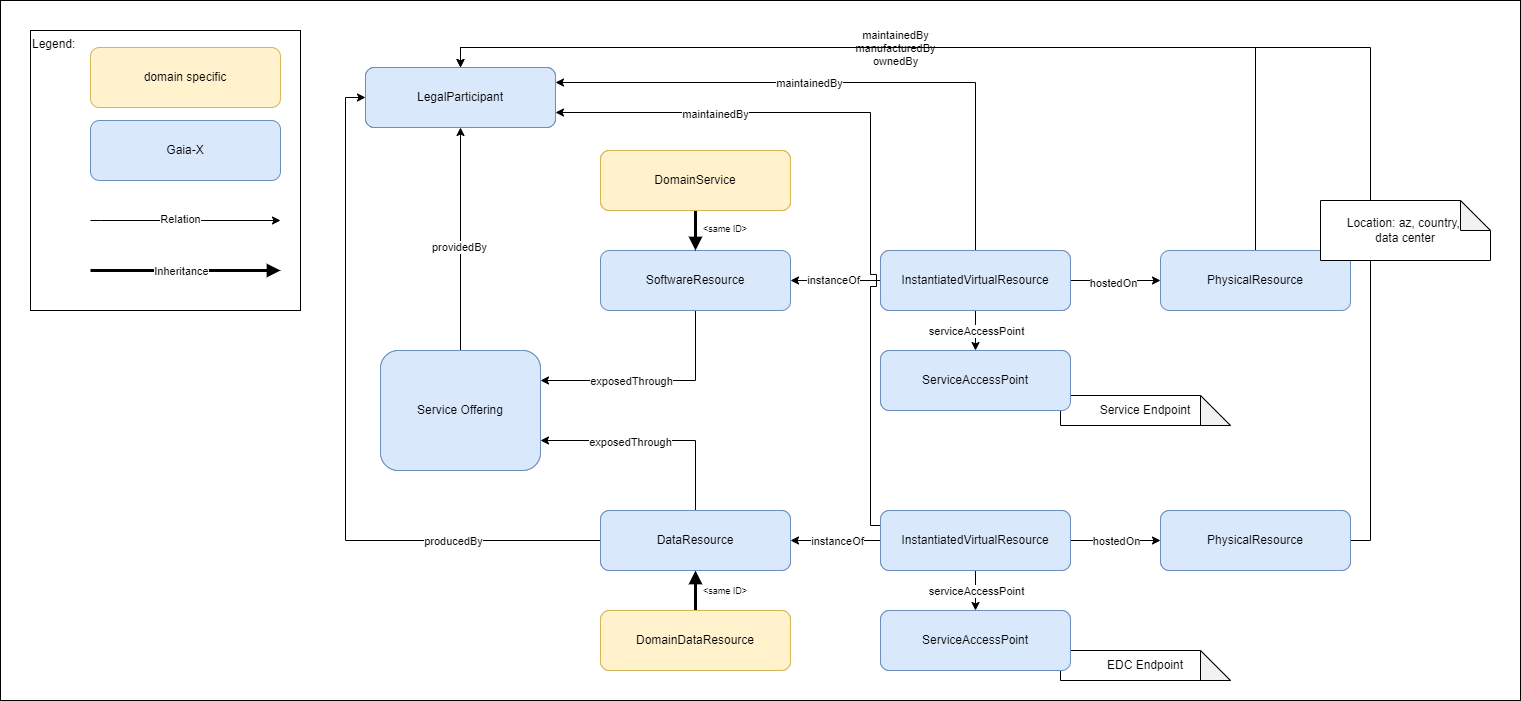This repository contains an overview of how to specify Gaia-X compliant claims. The claims are based on the Vocabulary defined in the Gaia-X Trust Framework Model 2210.
The Gaia-X Trust Framework consists of several classes and their attributes. These classes are used to describe the service or data that should be offered. We call that metadata. Here are the most relevant classes needed for creating basic claims:
The following diagrams provide a visual representation of the classes and how they are linked together.
This example shows a ServiceOffering which is provided by a certain LegalParticipant. In this example the ServiceOffering links a SoftwareResource as well as a DataResource with the exposedThrough relation.
Notes:
- Please note that a
ServiceOfferingcan link only one of theResources or even more depending on the use case that should be described. - There can be domain specific extensions to describe a ServiceOffering or a DataResource in more details (here:
DomainServiceandDomainDataResource. Those domain specific subclasses are defined in the ontology-management repository and loaded into the federated catalogue.
The DataResource or SoftwareResource are linked to the InstanciatedVirtualResource with the instanceOf relation. The ServiceAccessPoint then defines the EDC endpoint address or the service endpoint URL.
The PhysicalResource describes the infrastructure where the Resource is hosted and links back to the LegalParticipant with the relations maintainedBy, manufacturedBy and ownedBy.
The Model defines the classes and their dependencies needed to create a metadata description of the service or data to be offered.
'Claims' means the instantiation of the model into a concrete instance representing the metadata. In Gaia-X these claims are encapsulated into a W3C VerifiableCredential and a W3C VerifiablePresentation both having a proof (signature). Those VerifiablePresentations can be sent to the federated catalogue which is responsible for storing that meta-data description and making it discoverable.
The src directory contains an example for claims for the specific classes mentioned above. You can find more details in the respective claim files in the src directory.
Note:
The claims provided as an example could look different. In some cases the Gaia-X Trust Framework Model 2210 allows different approaches to describe the data, e. g. with sh:or.
Example:
[
sh:name "copyright owned by" ;
sh:or ( [ sh:class gx:LegalParticipant ] [ sh:datatype xsd:string ] ) ;
],
This means that one can link a list of LegalParticipant class to this object or just provide a simple strings.
The example claims can only show one of the possibilities. Please refer to the Gaia-X Trust Framework Model 2210 for more details.
- Links to the legalParticipant Credentials must always reference to the id of the legalParticipant and NOT the did of the issuer. Don't get confused by the "wrong " error of the Compliance Service that "Service and participant issuers must match". The issue is already mentioned here.
- The ID of the sublcass of a gaia-x class (marked as
domain specificin the picture above must have the same ID as the gaia-x superclass. This is necessary to make the claims discoverable in the federated catalogue.
There are some problems resulting of the current version of the Gaia-X Trust Framework Model 2210:
- The relation
exposedThroughis currently not modelled correctly.exposedThroughshould point to the data exchange component as written in the specification. This will be fixed in the next version of the Gaia-X Trust Framework.exposedThroughwill then link to the data exchange component and the relationship betweenServiceOfferingand theResourcewill be replaced byaggregationOf. - There is a similar issue in the
ServiceOfferingShape. The relationprovidedByis modelled as sh:node which means that we cannot link an existing participant by its ID. We expect hat this will be changed in future so a participant can be linked like inDataResourceShape.producedByproperty withsh:classandsh:nodeKind sh:IRI. - Another issue in the
ServiceOfferingShapeis that theLegalParticipantis not linked correctly.providedBydefines ash:node gx:LegalParticipantand notsh:node gx:LegalParticipantShape. As stated above the recommendation would be to link withsh:classandsh:nodeKind sh:IRI. - Regarding InstantiatedVirtualResource, the
hostedOnandinstanceOfattributes are not modelled as sh:nodeKind sh:IRI as it can be seen in the other attributes likemaintainedBy,manufacturedByandownedBy. For that reason we cannot use an IRI and link existing nodes but we need to embed thePhyicalResourceand theDataResourcedirectly into theInstantiatedVirtualResource. SeeInstanciatedVirtualResource-instance_adapted.jsonfor an example. - The
LegalParticipantcredential referenced in the Trust Framework 22.10 obviously has a different shape than the one that is accepted by the current Compliance Service.- The LegalParticipant-instance_20.10-conform.json is a version that is not accepted by the Compliance Service but relates to the LegalParticipantShape.
- The LegalParticipant-instance_compliance-service-conform.json is a version that is accepted by the Compliance Service but does not relate to the LegalParticipantShape.
- Please consult the README.md in ./src/LegalParticipant for more information.
These problems should be fixed in the next version of the Gaia-X Trust Framework.
see LICENSE

